Download
News 2012/23
Brian Wilson
Download News 2012/22 is here.
Recording
of the Month
Bella dama: Baroque cantatas
Antonio VIVALDI (1678-1741) Cessate,
omai cessate, RV684 [12:43]
Nicola PORPORA (1686-1768)
Salve Regina [16:27]
Alessandro SCARLATTI (1660-1725)
Tu sei quella che al nome (Bella dama di nome
santa) [13:25]
Infirmata vulnerata [15:40]
Raffaele Pé (counter-tenor)
Spiritato! (Kinga Ujszászi, James Toll (violins), Joanne
Miller (viola), Alice Manthorpe Saunders (cello), Kate Aldridge
(bass), László Rózsa (recorder), Jadran
Duncumb (theorbo),
Nicolás Mendoza (harpsichord/organ)
Pdf booklet with texts and translations included
RESONUS CLASSICS RES10115 [58:29] from resonusclassics.com
(mp3, aac and lossless flac) or stream from Naxos Music Library
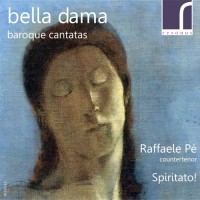 I’ve
come to expect enterprise from Resonus and this, their fifteenth
release in just over a year marks the recording debut of the
young counter-tenor Raffaele Pé and the group Spiritato!
in baroque sacred music. The Vivaldi piece is fairly well known,
though half the versions in the catalogue are permutations of
Sara Mingardo’s recording, but not the remaining works.
I’ve
come to expect enterprise from Resonus and this, their fifteenth
release in just over a year marks the recording debut of the
young counter-tenor Raffaele Pé and the group Spiritato!
in baroque sacred music. The Vivaldi piece is fairly well known,
though half the versions in the catalogue are permutations of
Sara Mingardo’s recording, but not the remaining works.
Andreas Scholl has recorded cessate, omai cessate with
other Vivaldi works on Harmonia Mundi HMC901571 (also
on a budget price sampler HMX2901726), one of only two
counter-tenor recordings of the piece generally available in
the UK. The accompaniment there is provided by Ensemble 415
and Chiara Banchini, so Pé and his supporters are up
against some tough competition. Apart from the second section,
ah ch’infelice sempre, which is notably slower on
the new recording, tempi are remarkably similar. More to the
point, Pé need fear no comparison with Scholl on the
basis of this performance in particular he sustains the slower
pace in that second section remarkably well and he is well supported
throughout.
Max Cencic and Ornamente 99/Erik Carsten on a Capriccio recording
(C67072 from classicsonline.com
(mp3) or stream from Naxos Music Library), again with other
Vivaldi works, take ah ch’infelice sempre even more
slowly than Pé; again he sustains the long line at the
slower tempo very well against a heavier accompaniment, but
this is another version with which Pé need fear no comparison.
Indeed, by comparison with Pé and Scholl Cencic sounds
a little plummy.
I couldn’t find any version of the Porpora or the first
Scarlatti work and the only recording that I could muster for
comparison with Pé in infirmata, vulnerata comes
from a decidedly plummy Susanna Anselmi (alto) and il Ruggero
on Tactus TC661903; there’s no contest here, with
a much more subtle accompaniment on Resonus and a solo part
clear and free from plumminess.
A strong contender for lovers of baroque vocal music; Raffaele
Pé is a discovery, indeed, a challenge to the likes of
Andreas Scholl and Philippe Jaroussky. If you have access to
Naxos Music Library you can try the recording there first.
Reissues
of the Month: Decca and DG in 24-bit sound from Linn
All of these releases come in mp3, 16 and 24-bit lossless,
with a choice of flac and alac in the last two cases. They are
reasonable value in mp3 at £8 about what you’d
pay for mp3 from most suppliers but it’s the 24/96 versions
that are really outstanding, making full use of the original
recording potential; albeit that the price of £18 is double
what you’d pay for mp3, I believe that you will find the
extra outlay worthwhile. Dan Morgan and I have already reviewed
some of these downloads but I’ve rounded up several more
below.
Ludwig van BEETHOVEN (1770-1827)
Violin Concerto in D, Op.61 (1806)
Felix MENDELSSOHN (1809-1847)
Violin Concerto in e minor, Op.64 (1844)
Viktoria Mullova (violin)
Orchestre Révolutionnaire et Romantique/John Eliot Gardiner
rec. June, 2002. DDD.
LINN/UNIVERSAL UNI054 [68:17] from linnrecords.com
(mp3, 16 and 24-bit flac.)
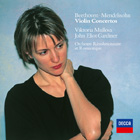 Tony
Haywood made the original (Philips 473 8722 review)
his Recording of the Month, though he admitted
that the enemies of period practice might not like it. I’m
as convinced as he was by the performance there’s very
little that I think even the non-period listeners could object
to, nothing shoved down unwilling throats and the recording,
which he described as superb, full and warm, sounds even better
in 24-bit format. Nothing will ever match the revelation of
the David Oistrakh performance of the Beethoven at the RFH which
I heard many years ago, but this recording is pretty revelatory
in its own right and the Beethoven/Mendelssohn coupling makes
a welcome change from the usual Mendelssohn/Bruch No.1 arrangement
which pairs two very similar works. Only the notes, which TH
thought excellent, are missing surely we might reasonably
expect them for £18?
Tony
Haywood made the original (Philips 473 8722 review)
his Recording of the Month, though he admitted
that the enemies of period practice might not like it. I’m
as convinced as he was by the performance there’s very
little that I think even the non-period listeners could object
to, nothing shoved down unwilling throats and the recording,
which he described as superb, full and warm, sounds even better
in 24-bit format. Nothing will ever match the revelation of
the David Oistrakh performance of the Beethoven at the RFH which
I heard many years ago, but this recording is pretty revelatory
in its own right and the Beethoven/Mendelssohn coupling makes
a welcome change from the usual Mendelssohn/Bruch No.1 arrangement
which pairs two very similar works. Only the notes, which TH
thought excellent, are missing surely we might reasonably
expect them for £18?
Frédéric CHOPIN
(1810-1849)
Piano Concerto No 1 in e minor, Op. 11 (1830) [40:29]
Piano Concerto No 2 in f minor, Op. 21 (1829) [31:51]
Krystian Zimerman (piano)
Los Angeles Philharmonic Orchestra/Carlo Maria Giulini rec.
1979 (Op. 11) and 1980 (Op. 21)
LINN/UNIVERSAL UNI073 [72:26] from linnrecords.com
(mp3, 16 and 24-bit lossless)
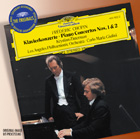 I
concur with Peter J Lawson who made the DG Originals reissue
of this classic recording his Bargain of the Month
review.
I’d place these performances only a little behind Rubinstein
(RCA) and Pollini (EMI, Concerto No.1). You can obtain an mp3
download of this recording for £7.49 (hmvdigital.com or
amazon.co.uk) and you could until recently have had the CD for
not much more amazingly, it seems to have been withdrawn already
in the UK. Even Zimerman’s 2-CD remake with the Polish
Festival Orchestra February 2010 Download Roundup
costs only £9.74 (hmvdigital.com), so is it worth paying
£18 for the 24/96 Studio Master flac or alac of the same
recording? If your system can cope with 24/96 the difference
in sound between good mp3 and the Studio Master is not exactly
earth-shattering but it is significant. Again, the lack of notes
is the only problem in recommending the Linn download.
I
concur with Peter J Lawson who made the DG Originals reissue
of this classic recording his Bargain of the Month
review.
I’d place these performances only a little behind Rubinstein
(RCA) and Pollini (EMI, Concerto No.1). You can obtain an mp3
download of this recording for £7.49 (hmvdigital.com or
amazon.co.uk) and you could until recently have had the CD for
not much more amazingly, it seems to have been withdrawn already
in the UK. Even Zimerman’s 2-CD remake with the Polish
Festival Orchestra February 2010 Download Roundup
costs only £9.74 (hmvdigital.com), so is it worth paying
£18 for the 24/96 Studio Master flac or alac of the same
recording? If your system can cope with 24/96 the difference
in sound between good mp3 and the Studio Master is not exactly
earth-shattering but it is significant. Again, the lack of notes
is the only problem in recommending the Linn download.
Concerto Veneziano
Antonio VIVALDI (1678 1741)
Concerto for Violin, Strings (‘in due cori’) and 2
Harpsichords in B flat, RV583 [18:16]
Concerto for Violin, Strings and Harpsichord in e minor, RV278
[14:43]
Pietro Antonio LOCATELLI (1695
1764)
Violin Concerto Op.3, No.9 (edited by Prof. Albert Dunning)
[18:49]
Giuseppe TARTINI (1692 1770)
Violin Concerto in A, D96 [18:13]
Giuliano Carmignola (violin)
Venice Baroque Orchestra/Andrea Marcon
LINN/UNIVERSAL UNI072 [65:34] from linnrecords.com
(mp3, 16 and 24-bit lossless)
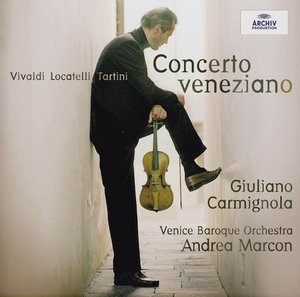 Here’s
another fine recording that seems to have been prematurely retired
on disc in the UK. One reviewer on its original appearance noted
that Giuliano Carmignola’s Vivaldi was not as adventurous
as Nigel Kennedy’s I take that as a considerable virtue
rather than as a criticism; I’m sorry to say that I hate
the way that Kennedy pulls Vivaldi about, much as I enjoy his
performances of other composers his first recording of the
Elgar Violin Concerto is my version of choice.
Here’s
another fine recording that seems to have been prematurely retired
on disc in the UK. One reviewer on its original appearance noted
that Giuliano Carmignola’s Vivaldi was not as adventurous
as Nigel Kennedy’s I take that as a considerable virtue
rather than as a criticism; I’m sorry to say that I hate
the way that Kennedy pulls Vivaldi about, much as I enjoy his
performances of other composers his first recording of the
Elgar Violin Concerto is my version of choice.
The performances are just right virtuoso without being as
overtly so as many recent Italian performers have been; indeed
RV583, especially the andante movement, is taken more sedately
than on either of the other recordings that I tried as is
the recording: a credible sound-stage in 24-bit sound without
being in-your-face hi-fi.
Without the notes not provided with the download I don’t
know what happened to the two harpsichords listed in RV583;
presumably they were deemed optional; they feature on the recording
by Camerata Bern/Thomas Zehetmair (Berlin Classics 0011642BC)
but by no means prominently; if they are present at all on the
recording by Combattimento Consort Amsterdam (Challenge Classics
CC72115) they are as inaudible as on the DG recording.
If it’s drama that you’re looking for in Vivaldi,
the Challenge Classics version will give it to you more than
the DG recording but Carmignola and Marcon offer a more balanced
view overall.
Camille SAINT-SAËNS (1835-1921)
Symphony No. 3 in c minor, Op.78 ‘Organ Symphony’*
[34:24]
Bacchanale from Samson et Dalila [7:15]
Prélude to Le Deluge Op.45 [7:36]
Danse macabre, Op.40 [6:51]
Gaston Litaize (organ)*
Chicago Symphony Orchestra*; Orchestre de Paris/Daniel Barenboim
rec. 1976 (Symphony). ADD.
LINN/UNIVERSAL UNI071 [56:04] from linnrecords.com
(mp3, 16 and 24-bit lossless)
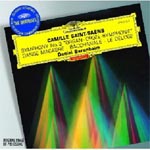 This
is by general consent the version of the symphony
to have unless you are irreconcilably opposed to having Gaston
Litaize’s performance of the organ part spliced on to Barenboim’s
with the Chicago Symphony thousands of miles away. It’s
a combination that works for me.
This
is by general consent the version of the symphony
to have unless you are irreconcilably opposed to having Gaston
Litaize’s performance of the organ part spliced on to Barenboim’s
with the Chicago Symphony thousands of miles away. It’s
a combination that works for me.
If you don’t like the suggestion of artificiality, there’s
another classic version from Berj Zamkochian (organ) with Charles
Munch and the Boston Symphony Orchestra (1959 stereo), one that
I owned and enjoyed on an RCA LP and now in a fine transfer
from Beulah Extra on 13-14BX32 December 2011/1 Roundup.
Alternatively, there’s Peter Hurford and Charles Dutoit,
coupled with the Poulenc Organ Concerto (Decca Originals 475
7728 from hmvdigital.com
for £4.99).
You can get the Litaize/Barenboim recording as a download in
mp3 for £5.49 from amazon.co.uk, though it’s likely
to be at 256kb/s rather than the full 320kb/s. (Ignore the rather
strange comment there from a purchaser who seems to have thought
that he was downloading a work for what he calls an ‘organ
barrel’ (barrel-organ?).) Once again, however, the 24-bit
Studio Master sound is unspectacularly revelatory.
[My colleague Dan Morgan is also listening to this download
watch this space.]
Jean SIBELIUS (1865-1957) Violin
Concerto in d, Op.47 [31:58]
William WALTON (1902-1983)
Violin Concerto [29:47]
Akiko Suwanai (violin);
City of Birmingham Symphony Orchestra/Sakari Oramo rec. 2002.
DSD
LINN/UNIVERSAL UNI057 [61:44] from linnrecords.com
(mp3, 16 and 24-bit lossless)
 I’m
not sure that this recording has ever been available on disc
in the UK except as an SACD-only import from Japan, so I was
intrigued to hear what I’d been missing, especially as
I’d read such good things about the soloist, Akiko Suwanai:
John Phillips, for example, was totally convinced by her in
the Bruch Concerto No.1 and Scottish Fantasia review;
as this is no longer generally available, perhaps Linn will
get together with Universal to give us a Studio Master download
version of this, too.
I’m
not sure that this recording has ever been available on disc
in the UK except as an SACD-only import from Japan, so I was
intrigued to hear what I’d been missing, especially as
I’d read such good things about the soloist, Akiko Suwanai:
John Phillips, for example, was totally convinced by her in
the Bruch Concerto No.1 and Scottish Fantasia review;
as this is no longer generally available, perhaps Linn will
get together with Universal to give us a Studio Master download
version of this, too.
There’s such a diversity of coupling for both of these
concertos, though none that I know of that pairs them, that
comparisons are less useful than usual, though it’s the
Nigel Kennedy recording of the Walton (EMI)
that sits in my unconscious nice to be complimentary about
him after being rude about his Vivaldi and Kyung-Wha Chung
(Decca Originals or Double Decca) or Leonidas Kavakos (BIS,
first and revised versions) in Sibelius.
It’s to the credit of both soloist and conductor that I
wasn’t tempted to play either of those named recordings
of the Sibelius after hearing this Decca version; that’s
hardly surprising when Sakari Oramo has given us so many recommendable
Sibelius recordings, including a fine version of the Violin
Concerto with Lisa Batiashvili (Sony review).
The slow movement is to die for taken a little more slowly
than usual.
The tempi in the Walton are close to those adopted by Kennedy
and Previn; were it not that I prefer the EMI coupling with
the Viola Concerto (now available only if you go for the 5-CD
set at budget price) I’d rate Suwanai and Oramo as the
equals of that now classic account.
As with all these 24-bit downloads, the quality of the sound
is very good credible without going out of its way to impress
but the lack of notes (again) reduces my enthusiasm slightly.
Bargain
of the Month
Igor STRAVINSKY (1882-1971)
Œdipus Rex (1926/7)
Ernst Haefliger (tenor) Oedipus
Hélène Bouvier (mezzo) Jocasta
James Loomis (bass-baritone) Créon and Messenger
André Vessières (bass) Tiresias
Hugues Cuénod (tenor) Shepherd
Paul Pasquier (speaker) Narrator
Société Chorale du Brassus; Orchestre de la Suisse
Romande/Ernest Ansermet rec.1955. ADD
HALLMARK [49:31] from emusic.com
(mp3)
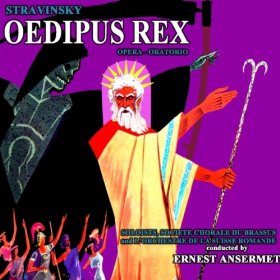 Like
the play by Sophocles on which it’s based, this is music
that one doesn’t come to terms with immediately. With narration
in French and sung text in Latin, the recording is rather dry
and distant, though by no means un-listenable. It’s worth
making the effort and it will cost you just £0.84 or
less or, if you’re not an emusic.com subscriber, a little
more (£1.38) from amazon.co.uk.
There are no notes, but you can find the booklet for the
Australian Eloquence reissue here.
Like
the play by Sophocles on which it’s based, this is music
that one doesn’t come to terms with immediately. With narration
in French and sung text in Latin, the recording is rather dry
and distant, though by no means un-listenable. It’s worth
making the effort and it will cost you just £0.84 or
less or, if you’re not an emusic.com subscriber, a little
more (£1.38) from amazon.co.uk.
There are no notes, but you can find the booklet for the
Australian Eloquence reissue here.
Emusic.com also have the 1960 Ancerl recording on Supraphon,
coupled with Symphony of Psalms review
for £2.10.
Discovery
of the Month
Trollfågeln The Magic Bird
Till Maria (for Maria) [5:00]
G-mollpolska efter Anders Gustaf Jernberg (Polska in
g minor) [3:25]
Ut i mörka natten (into the dark night) [4:55]
Isadoras land (Isadora’s land) [3:50]
Trollfuglen (the magic bird) [2:25]
Polska fra Hoffsmyran (Polska from Hoffsmyran) [4:02]
Herr Lager och skön fager (Herr Lager and the fair
beauty) [3:08]
Brännvinslåt från Torsås (Drinking
song from Torsås) [2:40]
Pigopolskan / Den glömda polskan (The Maid’s
Polska / The Forgotten Polska) [5:08]
När som flickorna de gifta sig (When young women
get married) [4:05]
Kapad (Hijacked) [4:44]
Bredals Näckapolska (Näckapolska after Bredal)
[3:01]
Galatea Creek [3:19]
Vals från Valsebo (Waltz from Valsebo) [8:56]
Emilia Amper (nyckelharpa, vocal)
Johan Hedin (nyckelharpa)
Anders Löfberg (cello)
Dan Svensson (percussion, guitar, vocals)
Olle Linder (percussion, guitar)
Helge Andreas Norbakken (percussion)
Strings of Trondheim Solistene: Johannes Rusten, Daniel Turcina
(violin); Frøydis Tøsse (viola), Marit Aspaas
(cello); Rolf Hoff Baltzersen (double bass) rec. April 2012.
DSD.
Pdf booklet
BIS BIS-SACD-2013 [59:42] from eclassical.com
(mp3, 16 and 24-bit lossless)
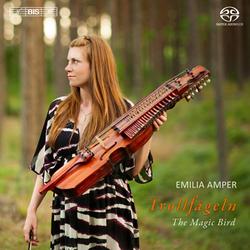 It’s
very difficult to describe the noise that the nyckelharpa, a
Swedish folk instrument sometimes translated as keyed fiddle,
makes, so I recommend that you try the previews of a track or
two from the eclassical.com website or, better still if you
can, listen to the album via the Naxos Music Library. It looks
about as large as an archlute and about as archaic you can
see it on the cover. The sound is enchanting, on its own and
when supported by the other instrumentalists on this recording,
and the vocals are equally enthralling.
It’s
very difficult to describe the noise that the nyckelharpa, a
Swedish folk instrument sometimes translated as keyed fiddle,
makes, so I recommend that you try the previews of a track or
two from the eclassical.com website or, better still if you
can, listen to the album via the Naxos Music Library. It looks
about as large as an archlute and about as archaic you can
see it on the cover. The sound is enchanting, on its own and
when supported by the other instrumentalists on this recording,
and the vocals are equally enthralling.
The first pages of the booklet are in Swedish, German and Japanese,
but persevere and you’ll find notes in English on each
individual piece.
Naxos
the chairman’s recommendations
Naxos chairman Klaus Heymann regularly makes recommendations
of recent recordings on that label for download from classicsoline.com
some of you may subscribe to his emails and they are all
worth paying attention to. The most recent set is particularly
interesting and varied.
Many of the more recent releases are being offered by classicsonline.com
in lossless flac, still good value at £5.99 when the CDs
now cost around £1 more than that, while the mp3 versions
remain at £4.99. Unfortunately I wasn’t able to obtain
any of these in flac.
The first volume of a new series of orchestral works by Maurice
RAVEL (1875-1937) comes on 8.572887
[67:37] Leonard Slatkin conducting the Orchestra National de
Lyon.
Alborada del gracioso [7:35]
Pavane pour une infante défunte [6:37]
Rapsodie espagnole [15:04]
Shéhérazade Ouverture de féerie
[13:02]
Menuet antique [6:43]
Boléro [15:18]
rec. September 2011. DDD. Pdf booklet included.
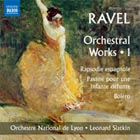 This
is not Slatkin’s first venture with this orchestra I
reviewed his recording of Berlioz’ Symphonie fantastique
favourably in a recent Download News (2012/20 here)
and my colleague Paul Corfield Godfrey thought it one of the
best review
though it’s been described in pejorative terms elsewhere.
Bravely, classicsonline.com have included that negative review,
typically forthright when you see who wrote it, on their website.
This
is not Slatkin’s first venture with this orchestra I
reviewed his recording of Berlioz’ Symphonie fantastique
favourably in a recent Download News (2012/20 here)
and my colleague Paul Corfield Godfrey thought it one of the
best review
though it’s been described in pejorative terms elsewhere.
Bravely, classicsonline.com have included that negative review,
typically forthright when you see who wrote it, on their website.
With plenty of recommendable Ravel recordings on the market*,
I didn’t think this special enough to deserve an outright
commendation there’s just a trace of mystery lacking
in some of the playing, as at times in the Pavane and
there are even some small technical shortcomings but it would
make a reasonable choice for anyone looking to embark on the
discovery of Ravel’s music, with four of his best-known
Spanish-flavoured works, including the ubiquitous and annoyingly
unshakeable Boléro, together with the much less well-known
but completely Ravelian Shéhérazade Overture
and a perky performance of the charming faux-early music
Menuet antique.
* sainsburysentertainment.co.uk,
for example, offer the 3-CD EMI download of Martinon performances
for just £6.99 and classicsonline.com
have a 2-CD set in the 20th-century classics series with performances
by Karajan, Munch et al for £5.99.
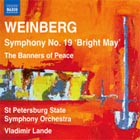
Naxos have set out to record all those symphonies
by Mieczyslaw WEINBERG (1919-1996)
confusingly, alias Vainberg) which were not recorded
by Chandos; the second volume is on 8.572752
[55:36] Symphony No.19, ‘Bright May’, Op.142 [34:04]
and The Banners of Peace, Op.143 [21:32], both written
in 1985 to commemorate the anniversary of the end of World War
II and performed here by the St Petersburg State Symphony Orchestra/Vladimir
Lande rec. April 2011, pdf booklet included.
It’s tempting to say that Weinberg’s music is like
Shostakovich. They are sometimes coupled, as in the case of
the Hänssler Shostakovich/Weinberg chamber music recording
which I reviewed in the 2012/20 Download News,
and the Kopelman Quartet’s Shostakovich Quartet No.10 and
Weinberg Piano Quintet on Nimbus which I reviewed
last year. There are similarities, not least in that these works
are no more unthinkingly celebratory than Shostakovich’s
end-of-war Eighth Symphony. Lovers of the one are likely to
appreciate the other, but that’s far from the whole picture.
I’ve no benchmark by which to judge these recordings but
the performances sound thoroughly idiomatic. More to the point,
they made some powerful music which I didn’t know accessible
to me. The recording is good, though this is a case when I’d
have preferred to have heard the lossless flac.
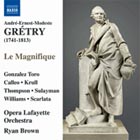 The
music of André-Ernest-Modeste
GRÉTRY (1741-1813) takes us back from the
late 20th century to the 18th. Naxos have released the premiere
recording of his opera Le Magnifique (1773), just squeezed
complete on one CD: 8.660305
[80:00] soloists and Opera Lafayette conducted by Ryan Brown
and recorded in February 2011. The pdf booklet has a synopsis;
it doesn’t contain the text but this can be accessed at
www.naxos.com/libretti/660305.htm.
The
music of André-Ernest-Modeste
GRÉTRY (1741-1813) takes us back from the
late 20th century to the 18th. Naxos have released the premiere
recording of his opera Le Magnifique (1773), just squeezed
complete on one CD: 8.660305
[80:00] soloists and Opera Lafayette conducted by Ryan Brown
and recorded in February 2011. The pdf booklet has a synopsis;
it doesn’t contain the text but this can be accessed at
www.naxos.com/libretti/660305.htm.
I have to admit that just about the only music that I knew by
Grétry was the ballet from Céphale et Procris,
reissued by Beulah (1BX138 June 2011/2 Download Roundup)
and the Beecham lollipop, the ballet suite from Zémire
et Azor he performed the whole work, too, but I’ve
yet to make the acquaintance of the 2-CD Somm set on which the
live recording has recently been issued (SOMM030-2
review
and review:
Recording of the Month). Le Magnifique contains
some very tuneful music of great charm, though I thought it
no great shakes dramatically 18th-century art and literature,
but not the music, are my blind spots, so you may think otherwise.
As this is a premiere recording there’s nothing to compare
it with, but I can’t imagine the performances being bettered
and the recording is good. There’s a lossless flac version
one from eclassical.com, too but the mp3 with which I was
supplied for review is more than adequate.
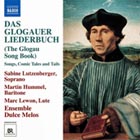 The
music from the Glogauer Liederbuch takes us further
back, sacred and secular songs and instrumental music from the
junction of the late medieval and the early renaissance in the
15th century music not just from Germany but from all corners
of Europe. The selection on Naxos 8.572576
has been chosen (deliberately?) to avoid that already available
on Oehms OC417, also available from classicsonline.com
(mp3).
The
music from the Glogauer Liederbuch takes us further
back, sacred and secular songs and instrumental music from the
junction of the late medieval and the early renaissance in the
15th century music not just from Germany but from all corners
of Europe. The selection on Naxos 8.572576
has been chosen (deliberately?) to avoid that already available
on Oehms OC417, also available from classicsonline.com
(mp3).
The music is instantly likeable. The performances by Sabine
Lutzenberger (soprano), Martin Hummel (baritone), Marc Lewon
(lute) and Ensemble Dulce Melos were recorded in August 2010.
They do justice to the music except that Lutzenberger’s
voice is smaller than Hummel’s in duets and the instruments
sometimes swamp her slightly in solos, though she has a very
pure tone and shines powerfully on other tracks, as in Der
Morgenstern (trs.8-10). The pdf booklet includes detailed
descriptions of each song and the texts in NHG (Early Modern
German), Modern German and English can be accessed at www.naxos.com/libretti/572576.htm.
The recording, available in mp3 only, is good.
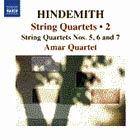 Back
to the 20th century for the music of Paul
HINDEMITH (1895-1963), the second and final volume
of his String Quartets containing Nos. 5, 6 and 7 in performances
by the Amar Quartet, named after the ensemble with whom Hindemith
performed his own music, recorded in April 2010. (Naxos 8.572164
pdf booklet included [71:13]). As Klaus Heymann points out,
the rival CPO recording of the Hindemith quartets by the Danish
Quartet runs to three CDs, but it does also contain the real
No.1, Op.2.
Back
to the 20th century for the music of Paul
HINDEMITH (1895-1963), the second and final volume
of his String Quartets containing Nos. 5, 6 and 7 in performances
by the Amar Quartet, named after the ensemble with whom Hindemith
performed his own music, recorded in April 2010. (Naxos 8.572164
pdf booklet included [71:13]). As Klaus Heymann points out,
the rival CPO recording of the Hindemith quartets by the Danish
Quartet runs to three CDs, but it does also contain the real
No.1, Op.2.
Byzantion thought Volume 1 (Quartets 2 and 3, formerly known
as Nos.1 and 2 review)
a must-have for lovers of 20th-century music. The three powerful
quartets on Volume 2 are just as well performed as those on
Volume 1 and the recording is very good, albeit in mp3 only
from classicsonline.com.
Time precludes my writing about the other recordings in this
month’s Chairman’s recommendations; I hope to get
round to them in the next Download News:
8.572742 Ries
Piano Concertos, Volume 5.
8.572730 Rihm
Complete works for violin and piano
8.573005 Casella
La donna serpente; Introduzione, aria e toccata;
Partita for piano and orchestra
8.660319-21 de Almeida
La Spinalba ovvero il vecchio matto
8.572448 Asian Music for string quartet

Music
for Advent and Christmas
A Piano Christmas in the 1920s
Anonymous: Holiday by the Fireside [3:30]
Howard BROCKWAY Christmas
Carols No. 1 [4:25]
Leslie LOTH Christmas Carols
No. 2 [6:37]
Adam CARROLL Christmas Greeting
[5:30]
Christmas Greetings ‘Twilight’ [9:51]
Leon JESSEL Parade of the
Wooden Soldiers (arr. for piano 4 hands) [2:58]
Adam CARROLLGrandmother’s
Christmas [9:16]
Fritz KREISLER Toy Soldier’s
March (arr. for piano) [2:09]
Anonymous, arr. John Tasker HOWARD
First Nowell (arr. for piano) [3:15]
Pietro Alessandro YON Gesu
bambino (arr. for piano) [4:55]
Leslie LOTH a Christmas
Eve Fantasy [9:21]
Fritz Kreisler, Adam Carroll and other Ampico pianists from
the 1920s
Pdf booklet included.
LYRICHORD CLASSICAL LYRCD6012 [61:47] from classicsonline.com
(mp3) or stream from Naxos Music Library
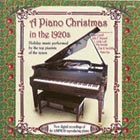 Looking
for something different this year? This could be it piano
roll recordings from the 1920s performed by star pianists for
Ampico, the very latest thing to have at the time for your reproducing
piano, which, as the notes point out, was a superior beast to
the player piano. Certainly there’s a fullness to the sound
here, as played on a restored 1929 Haines Bros. grand piano
with a late model Ampico A system. Inevitably some of the nuance
of live playing is lost in reproduction there’s a touch
of mechanical stiffness about the result that means that you
wouldn’t mistake anything here for the real thing, but
it’s all very entertaining and you even get Kreisler
played by Kreisler.
Looking
for something different this year? This could be it piano
roll recordings from the 1920s performed by star pianists for
Ampico, the very latest thing to have at the time for your reproducing
piano, which, as the notes point out, was a superior beast to
the player piano. Certainly there’s a fullness to the sound
here, as played on a restored 1929 Haines Bros. grand piano
with a late model Ampico A system. Inevitably some of the nuance
of live playing is lost in reproduction there’s a touch
of mechanical stiffness about the result that means that you
wouldn’t mistake anything here for the real thing, but
it’s all very entertaining and you even get Kreisler
played by Kreisler.
Jakub Jan RYBA (1765-1815)
Czech Christmas Mass ‘Hej, mistre’ (Hail, Master!)
[41:12]
Missa Pastoralis [13:28]
Vladimir Dolezal (tenor), Josef Ksica (organ), Pavla Ksicova
(contralto), Vaclav Sibera (bass), Dagmar Vankatova (soprano)
Czech Madrigalists Orchestra; Czech Madrigalists Choir/Frantisek
Xaver Thuri rec. 1998. DDD.
NAXOS 8.554428 [54:43] from eclassical.com
(mp3 and lossless), classicsonline.com
(mp3) or stream from Naxos Music Library. Pdf booklet from classicsoline.com
or NML.
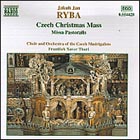 There
are several recordings of Ryba’s charming Christmas Mass;
I endorsed a version on Supraphon December 2011/2 Download
Roundup
and John Sheppard recently commended the new version from
ArcoDiva review
who already had an earlier version on their books, but this
Naxos recording easily holds its place among them.
There
are several recordings of Ryba’s charming Christmas Mass;
I endorsed a version on Supraphon December 2011/2 Download
Roundup
and John Sheppard recently commended the new version from
ArcoDiva review
who already had an earlier version on their books, but this
Naxos recording easily holds its place among them.
Classicsonline.com offer it in mp3 only for £4.99 as
reviewed in my Christmas 2009 Roundup
but eclassical.com have both mp3 and superior flac for $9.84,
which works out about even with the UK price of the CD.
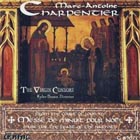 There
are several recommendable recordings of Marc-Antoine
CHARPENTIER (1643-1704) Messe de Minuit, H9,
which employs traditional French carol tunes for each of the
movements of the Mass but I’d overlooked a recording of
that work and the Magnificat, H73, from the Virgin Consort/Kylie
Brown on the Gothic label (G49077 from eclassical.com,
mp3 and lossless). There’s real ambience on this recording
and a degree of traffic noise and Charpentier’s music
is performed, in spirited fashion, in the context of an actual
Mass of the Nativity, complete with plainsong propers, beginning
with the Introit Dominus dixit ad me. The lack of texts
is less of a disadvantage than it might be, since the texts
of the common of the Mass and the propers for Christmas are
not hard to come by. The lossless recording is good. This recording
presents a strong challenge to the Erato version conducted by
William Christie which I mentioned favourably in the 2008 Christmas
Roundup.
There
are several recommendable recordings of Marc-Antoine
CHARPENTIER (1643-1704) Messe de Minuit, H9,
which employs traditional French carol tunes for each of the
movements of the Mass but I’d overlooked a recording of
that work and the Magnificat, H73, from the Virgin Consort/Kylie
Brown on the Gothic label (G49077 from eclassical.com,
mp3 and lossless). There’s real ambience on this recording
and a degree of traffic noise and Charpentier’s music
is performed, in spirited fashion, in the context of an actual
Mass of the Nativity, complete with plainsong propers, beginning
with the Introit Dominus dixit ad me. The lack of texts
is less of a disadvantage than it might be, since the texts
of the common of the Mass and the propers for Christmas are
not hard to come by. The lossless recording is good. This recording
presents a strong challenge to the Erato version conducted by
William Christie which I mentioned favourably in the 2008 Christmas
Roundup.
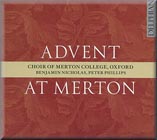 You’ll
find full details of Advent at Merton (Delphian DCD34122
mp3 from classicsonline.com
or stream from Naxos Music Library, both with pdf booklet) with
John Quinn’s review.
I’m pleased to see how music has blossomed since the foundation
of the choir in 2008, now under the joint ægis of Peter
Phillips, director of the Tallis Scholars and Benjamin Nicholas
it always seemed a shame that such a fine chapel was going
to musical waste. With a series of commissioned new settings
of the great Advent Antiphons at its heart, this well-sung programme
deserves to be on your Christmas list if you’re prepared
to be a bit adventurous in any case, there’s nothing
too avant-garde here.
You’ll
find full details of Advent at Merton (Delphian DCD34122
mp3 from classicsonline.com
or stream from Naxos Music Library, both with pdf booklet) with
John Quinn’s review.
I’m pleased to see how music has blossomed since the foundation
of the choir in 2008, now under the joint ægis of Peter
Phillips, director of the Tallis Scholars and Benjamin Nicholas
it always seemed a shame that such a fine chapel was going
to musical waste. With a series of commissioned new settings
of the great Advent Antiphons at its heart, this well-sung programme
deserves to be on your Christmas list if you’re prepared
to be a bit adventurous in any case, there’s nothing
too avant-garde here.
Beulah Extra
All these recordings can be found at http://www.eavb.co.uk/dec/index12.html
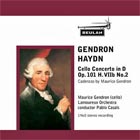 My
personal favourite of Beulah’s reissues this month is the
performance of Joseph HAYDN’s
(1732-1809) Cello Concerto in D, with Maurice Gendron (cello)
and the Lamoureux Orchestra conducted by Pablo Casals (1-3BX146).
Not the least of the virtues of this recording apart from
the fact that the Philips LP, borrowed from the university record
library, introduced me to the work is the fact that a veteran
cellist conducted the orchestra. The coupling was the spurious
but ubiquitous Grützmacher arrangement of a Boccherini
cello concerto (Correction: My thanks to an acute reader, Mark
Todd, who has reminded me that Gendron and Casals studiously
avoided the corrupt Grützmacher edition of the Boccherini
concerto - the first recording of the work to do so and well
worth consideration for another Beulah reissue).
My
personal favourite of Beulah’s reissues this month is the
performance of Joseph HAYDN’s
(1732-1809) Cello Concerto in D, with Maurice Gendron (cello)
and the Lamoureux Orchestra conducted by Pablo Casals (1-3BX146).
Not the least of the virtues of this recording apart from
the fact that the Philips LP, borrowed from the university record
library, introduced me to the work is the fact that a veteran
cellist conducted the orchestra. The coupling was the spurious
but ubiquitous Grützmacher arrangement of a Boccherini
cello concerto (Correction: My thanks to an acute reader, Mark
Todd, who has reminded me that Gendron and Casals studiously
avoided the corrupt Grützmacher edition of the Boccherini
concerto - the first recording of the work to do so and well
worth consideration for another Beulah reissue).
The Haydn Concerto in C had not been discovered at the time;
Gendron performed that later with the LSO and Raymond Leppard
together with another Boccherini concerto, last seen on Philips
Concert Classics 422 4812 (available only from ArkivMusic).
The recording, in stereo from 1960, has come up sounding very
well in this transfer. Only the Rostropovich recording of both
Haydn cello concertos (EMI GROC review)
can claim more classic status and I’m glad to see it reissued.
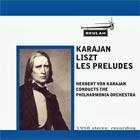 Another
classic recording, Herbert von Karajan with the Philharmonia
Orchestra in Franz LISZT (1811-1886)
Les Préludes was recorded in 1958 in stereo (10BX18).
The performance is one of the best ever set down and the recording
still sounds fine, even if it doesn’t open out quite as
spaciously as more modern versions. This recording was available
on the IDIS label (Karajan Spectacular No.1, IDI6592)
but that, too, is available as a download only now and comes
with other works which you may not want.
Another
classic recording, Herbert von Karajan with the Philharmonia
Orchestra in Franz LISZT (1811-1886)
Les Préludes was recorded in 1958 in stereo (10BX18).
The performance is one of the best ever set down and the recording
still sounds fine, even if it doesn’t open out quite as
spaciously as more modern versions. This recording was available
on the IDIS label (Karajan Spectacular No.1, IDI6592)
but that, too, is available as a download only now and comes
with other works which you may not want.
There are several fine recordings of Ludwig
van BEETHOVEN’s (1770-1827) Septet, Op.20, the
charming work that inspired Schubert’s even more wonderful
Octet. Beulah have reissued the 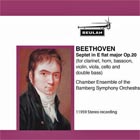 Bamberg
Symphony Chamber Ensemble (stereo, 1959) on 1-6BX199
[31:37]. My first choice in this work is the Vienna Octet
(Eloquence 480 2403, 2 CDs for around £11) or,
for a combination of performance quality and excellent value,
the Gaudier Ensemble on budget-price Hyperion Helios CDH55189,
with the Sextet, Op.81b, for just £5.99 in mp3 or lossless
sound, but the Beulah reissue is good value too £3.00/$4.80
for all six tracks. There’s also a version well worth considering
from Ensemble 360 on Nimbus (NI6112 review).
Bamberg
Symphony Chamber Ensemble (stereo, 1959) on 1-6BX199
[31:37]. My first choice in this work is the Vienna Octet
(Eloquence 480 2403, 2 CDs for around £11) or,
for a combination of performance quality and excellent value,
the Gaudier Ensemble on budget-price Hyperion Helios CDH55189,
with the Sextet, Op.81b, for just £5.99 in mp3 or lossless
sound, but the Beulah reissue is good value too £3.00/$4.80
for all six tracks. There’s also a version well worth considering
from Ensemble 360 on Nimbus (NI6112 review).
Both the Vienna Octet and the Gaudier Ensemble are more generous
than the Bamberg players with repeats in the first movement
and the fourth, theme and variations, and both give the music
a little more time to breathe in general, yet the Bambergers
never sound hurried, even at the fast tempo they adopt for the
scherzo fifth movement, and the recording, if a trifle
on the ‘warm’ side, sounds well in this transfer.
The Dolmetsch Ensemble were pioneers in playing early
music on the recorder. On 1BX94
[2:27] they play an anonymous Almain and Scots March
in sprightly fashion, recorded in stereo in 1961 and still sounding
well. This is all too short more, please.
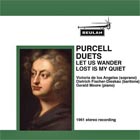 I
don’t recall Victoria de los Angeles and Dietrich Fischer-Dieskau
recording much together but they make a fine-sounding combination
with Gerald Moore at the piano in Henry
PURCELL’s Duets, Let us wander and Lost
is my quiet, on 1BX163
[4:51] recorded in stereo in 1961 and still sounding well.
I
don’t recall Victoria de los Angeles and Dietrich Fischer-Dieskau
recording much together but they make a fine-sounding combination
with Gerald Moore at the piano in Henry
PURCELL’s Duets, Let us wander and Lost
is my quiet, on 1BX163
[4:51] recorded in stereo in 1961 and still sounding well.
We’ve had plenty of reissues of military music from Beulah
in recent months in performances from the Eastman Wind Ensemble
directed by Frederick Fennell, but this month they feature in
more unusual, earlier repertoire from the Gabrielis, uncle and
nephew, recorded in stereo in 1960.
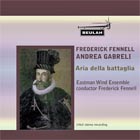 Andrea
GABRIELI’s Aria della battaglia comes
on 39BX182
[14:28]. It’s still well worth hearing though we’re
used to hearing it played less majestically and at a rather
faster tempo these days; for a clip of the Eastman Ensemble
playing this work many years later in more sprightly fashion,
go to YouTube.
Andrea
GABRIELI’s Aria della battaglia comes
on 39BX182
[14:28]. It’s still well worth hearing though we’re
used to hearing it played less majestically and at a rather
faster tempo these days; for a clip of the Eastman Ensemble
playing this work many years later in more sprightly fashion,
go to YouTube.
From Giovanni GABRIELI:
40BX182:
Sonata octavi toni [5:15]
41BX182:
Sonata pian’ e forte [5:25]
42BX182:
Canzon duodecimi toni [5:34]
43BX182:
Canzon noni toni [5:26]
44BX182:
Canzon septimi toni/1 [4:41]
45BX182:
Canzon quarti toni [5:03]
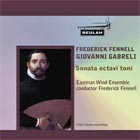 There
are more modern versions of this bold and attractive music,
some of the first to feature instruments in their own right
rather than accompanying the voice, but these Mercury recordings,
grand and unhurried, are rather special and it’s good to
have them available again, not just as historical curiosities
or as demonstrating the range of Fennell’s musical interests
like Gendron’s Haydn they’re more valuable than
that in their own right. If you’re new to this repertoire
and wonder where to start, the sonata pian’e forte is the
best known of these pieces.
There
are more modern versions of this bold and attractive music,
some of the first to feature instruments in their own right
rather than accompanying the voice, but these Mercury recordings,
grand and unhurried, are rather special and it’s good to
have them available again, not just as historical curiosities
or as demonstrating the range of Fennell’s musical interests
like Gendron’s Haydn they’re more valuable than
that in their own right. If you’re new to this repertoire
and wonder where to start, the sonata pian’e forte is the
best known of these pieces.
For follow-ups please refer to my review of two recordings of
Giovanni Gabrieli’s music canzonas played on the organ
with cornetti in some of the pieces and Sacred Symphonies, due
to appear on the main MusicWeb International pages but reprinted
for convenience below.
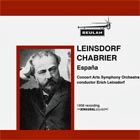 If
you know only one work by Emmanuel
CHABRIER it’s almost bound to be his rhapsody
España, once famous in arrangement as a pop song
Oh what you do to me, if memory serves aright. You’re
not likely to find a better performance than that given by Erich
Leinsdorf with the Concert Arts Symphony Orchestra in stereo
in 1958 on 26BX118
[6:11] and the recording still sounds first rate.
If
you know only one work by Emmanuel
CHABRIER it’s almost bound to be his rhapsody
España, once famous in arrangement as a pop song
Oh what you do to me, if memory serves aright. You’re
not likely to find a better performance than that given by Erich
Leinsdorf with the Concert Arts Symphony Orchestra in stereo
in 1958 on 26BX118
[6:11] and the recording still sounds first rate.
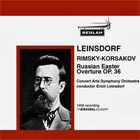 Nikolay
RIMSKY-KORSAKOV’s Russian Easter Festival
Overture is a gloriously wallowy piece of music with which
I’ve been in love for years. It counts with Balakirev’s
First Symphony as one of my favourite Russian works and the
performance from Erich Leinsdorf again with Felix Slatkin’s
foundation, the Concert Arts orchestra, on 3BX118
[13:41] is about as good as it gets. The sound, though canned
as long ago as 1958 (stereo) is first-rate in fact, the even
older Ansermet recording (Eloquence), its strongest rival, is
of around the same vintage. Leinsdorf and the Concert Arts orchestra
also recorded Rimsky’s Sheherazade for Capitol;
it’s been reissued by Urania, perhaps we might have that,
too, from Beulah.
Nikolay
RIMSKY-KORSAKOV’s Russian Easter Festival
Overture is a gloriously wallowy piece of music with which
I’ve been in love for years. It counts with Balakirev’s
First Symphony as one of my favourite Russian works and the
performance from Erich Leinsdorf again with Felix Slatkin’s
foundation, the Concert Arts orchestra, on 3BX118
[13:41] is about as good as it gets. The sound, though canned
as long ago as 1958 (stereo) is first-rate in fact, the even
older Ansermet recording (Eloquence), its strongest rival, is
of around the same vintage. Leinsdorf and the Concert Arts orchestra
also recorded Rimsky’s Sheherazade for Capitol;
it’s been reissued by Urania, perhaps we might have that,
too, from Beulah.
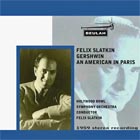 Felix
Slatkin conducts his ‘other’ orchestra, the Hollywood
Bowl Symphony, in a snappy performance of George
GERSWHIN’s An American in Paris on 1BX159,
recorded in stereo in 1959 [17:48]. I’ve heard more raucous
car horns in this work, but that’s my only (small) grumble.
The sound may be a trifle thinner than more recent recordings,
but you’d hardly notice. This recording is also available
(download only) for £1.99, though not in the USA and some
other countries, on Naxos Historical Archives 9.80143, coupled
with Rhapsody in Blue (1956). If you don’t want
the Rhapsody, the Beulah transfer half the music for around
half the price will do very nicely.
Felix
Slatkin conducts his ‘other’ orchestra, the Hollywood
Bowl Symphony, in a snappy performance of George
GERSWHIN’s An American in Paris on 1BX159,
recorded in stereo in 1959 [17:48]. I’ve heard more raucous
car horns in this work, but that’s my only (small) grumble.
The sound may be a trifle thinner than more recent recordings,
but you’d hardly notice. This recording is also available
(download only) for £1.99, though not in the USA and some
other countries, on Naxos Historical Archives 9.80143, coupled
with Rhapsody in Blue (1956). If you don’t want
the Rhapsody, the Beulah transfer half the music for around
half the price will do very nicely.
There’s plenty of military music again this month, though
not with Frederick Fennell at the helm this time:
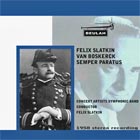 Concert
Artists Symphonic Band conducted by founder Felix Slatkin
plays five rousing American Marches in fine
form and in good stereo sound from 1958:
Concert
Artists Symphonic Band conducted by founder Felix Slatkin
plays five rousing American Marches in fine
form and in good stereo sound from 1958:
2BX159
Anchors aweigh [2:59]
3BX159
van BOSKERCK Semper paratus
[2:44]
4BX159
John Stanley SMITH Star-Spangled
Banner [1:47]
5BX159
Edwin BAGLEY National Emblem
March [3:00]
6BX159
Josef Franz WAGNER Under the
Double Eagle [2:33]
There’s more military music than I can
shake a stick at or give you all the details of, all self-recommending
to aficionados:
1-4BX203:
Marches played by the Band of the Coldstream Guards directed
by Lt. Col. Douglas A Pope
1BX202:
Sir Arthur SULLIVAN March
of the Peers Royal Artillery Band/Major Sidney Hays
2BX202:
Hermann KOENIG Post Horn Galop
Royal Artillery Band/Major Sidney Hays
Details from eavb.co.uk
On 1-24BX201
twenty-four Regimental Marches of the British Army
played by the Royal Military School of Music directed by Lt
Col David McBain; you’ll find them all listed at eavb.co.uk.
***
Giovanni GABRIELI
(1544/47-1612) Canzoni
Canzon XXVIII Sol sol la sol fa mi a 8 [2:09]
Canzon francese del duodecimo tono [3:23]
Canzon del duodecimo tono [2:14]
Canzon del duodecimo tono [3:16]
Canzon III a 6 [4:11]
Toccata dell’ottavo tono [2:36]
Ricercar dell’ottavo tono [5:07]
Canzon del secondo tono [2:31]
Motetto Jubilate Deo a 8 [5:14]
Canzon I La Spiritata a 4 [3:15]
Canzon II a 4 del duodecimo tono [2:53]
Canzon III a 4 del duodecimo tono [2:08]
Canzon IV a 4 del duodecimo tono [2:19]
Motetto O Doctor optime a 6 [5:18]
Toccata del primo tono [3:32]
Ricercar del primo tono [3:08]
Sonata I a 5 [3:21]
Canzon del decimo tono [2:15]
Fuga del nono tono [2:33]
Ricercar del decimo tono [4:35]
Canzon del decimo tono [4:08]
Fuga del nono tono [4:25]
Canzon XXVII Fa sol la re a 8 [3:29]
Liuwe Tamminga (organs), Bruce Dickey, Doron Sherwin (cornetti)
rec. San Petronio in Bologna, Italy, 7-9 January 2012. DDD
PASSACAILLE PAS994 [78:21] CD; not yet available as
a download
Sacred Symphonies
Vox Domini super aquas Jordanis C64 [5:52]
In ecclesiis C78 [7:25]
Canzon primi toni a 10 C176 [3:15]
O Jesu mi dulcissime C24 [5:07]
Omnes gentes plaudite manibus C52 [4:01]
O Jesu mi dulcissime C56 [6:21]
Kyrie C71-73 [6:43]
Maria virgo C35 [4:56]
Magnificat C75 [5:38]
Litaniæ Beatæ Mariæ Virginis C63 [12:10]
Exultet iam angelica turba C131 [4:41]
Ex Cathedra
His Majestys Sagbutts and Cornetts
Concerto Palatino/Jeffrey Skidmore
rec. All Hallows Church, Gospel Oak, London, 27-29 May 2012.
DDD.
Texts and translations included
HYPERION CDA67957 [66:16] CD or mp3 or 16 or 24-bit
lossless download with pdf booklet from hyperion-records.co.uk
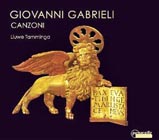
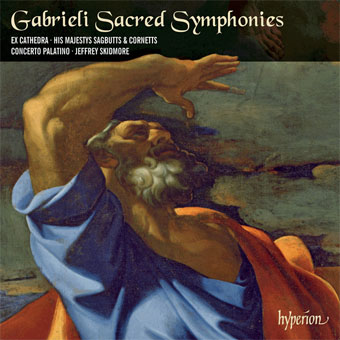 Two
recent and quite different takes on the music of the 16th-century
Venetian composer Giovanni Gabrieli. The Passacaille
CD offers mostly instrumental canzoni, normally performed by
cornets and sackbuts or their modern equivalents the first
recording that I heard was by the Philip Jones Brass Ensemble
but here on a pair of historic organs, with the assistance
of one or two cornetti in some of the pieces. In addition organ
transcriptions of two motets are included. The recording was
made on the Epistle and Gospel organs in the church of San Petronio
in Bolgna, instruments which date from the late 15th/early 16th
and later 16th century respectively and which give a fair indication
of how the music of the Gabrielis might have sounded in St Mark’s.
Two
recent and quite different takes on the music of the 16th-century
Venetian composer Giovanni Gabrieli. The Passacaille
CD offers mostly instrumental canzoni, normally performed by
cornets and sackbuts or their modern equivalents the first
recording that I heard was by the Philip Jones Brass Ensemble
but here on a pair of historic organs, with the assistance
of one or two cornetti in some of the pieces. In addition organ
transcriptions of two motets are included. The recording was
made on the Epistle and Gospel organs in the church of San Petronio
in Bolgna, instruments which date from the late 15th/early 16th
and later 16th century respectively and which give a fair indication
of how the music of the Gabrielis might have sounded in St Mark’s.
Hyperion offer a programme of vocal music with cornet
and sackbut accompaniment and one canzon at the centre
of the programme, a welcome return from Ex Cathedra and Geoffrey
Skidmore and an equally welcome sequel to His Majesty’s
Sagbutts and Cornetts’ earlier recording of Giovanni Gabrieli’s
instrumental canzoni, interspersed with some organ toccatas
from Timothy Roberts and Richard Egarr on Hyperion CDA66908
[74:52] from hyperion-records.co.uk
on CD or mp3 or lossless download.
On CDA66908 the predominant tone is provided by the brass
instruments with the organ filling the tone in the background,
except on the toccatas and the intonazione, designed
for the organ alone. On the new Passacaille recording the organs
provide the lion’s share of the sound, with one or both
cornets filling in on five tracks. Overall the sound is less
rich but more varied, since the organist can vary the registration
specified in each case in the booklet and, indeed, by using
either the smaller or larger of the two organs. A degree of
grandeur is lost in the process but the performances are persuasive
in their own right.
However it’s performed the music of Giovanni Gabrieli makes
a glorious sound and that’s true of both these recordings
but especially of the Hyperion. To paraphrase Beecham’s
comments on the English attitude to music, even if you don’t
like the music, you’ll love the sound it makes. The music
of the Gabrielis, uncle Andrea and nephew Giovanni, is particularly
colourful and it’s hardly surprising that it influenced
Monteverdi and their joint influence spread as far as Germany
where it coloured the music of Schütz and many of his contemporaries.
Ex Cathedra have already amply proved their ability to do colourful
in three Hyperion recordings of Latin American music of this
period:
New World Symphonies CDA67380
or CDA30030 review
Moon, Sun and all things CDA67524 review
Fire burning in snow CDA67600 review
(all three recordings are included in my survey of Hyperion
Top 30 review).
The new Hyperion recording is every bit as
colourful and enjoyable as those earlier releases and the works
offered add to our knowledge of Giovanni’s music only
In ecclesiis makes a regular appearance on other recordings,
as, for example, on the Decca Eloquence reissue of the music
of the Gabrielis, The Glory of Venice, which many will
have chosen as an excellent introduction (448 9932).
I compared the new recording with Stephen Cleobury’s performance
of his own arrangement of In ecclesiis on an earlier
(Argo) incarnation of the Eloquence recording and, while both
are good, they are chalk and cheese, with Cleobury slower, more
introspective and dignified at the beginning and building to
a climax and Geoffrey Skidmore offering a much more colourful
approach throughout. There’s a place for both, as also
for the recording from the Taverner Choir and Players under
Andrew Parrott which used to be available on Virgin, but I think
it’s to the new Hyperion that I shall return most often
now. Much as I admire Parrott, his recording now sounds quite
slow and tame by comparison.
The Hyperion recording is available on CD or as a download;
mp3 and 16-bit lossless are available directly from Hyperion
follow the link above for £7.99. The 24-bit is a little
more expensive at £12.00 but be aware that this is, unusually,
at 88.2 kHz some reproducing systems which cope with 24/96
and even 24/192 are stymied by 24/88.2. I listened to the CD-quality
16-bit lossless version and to the physical CD of the Passacaille.
Both are very good.
Both recordings come with excellent documentation as an Adobe
pdf document if you download the Hyperion. In the case of Hyperion
excellence is almost a given and it applies to the earlier
recording from the Sagbutts and Cornetts too but the Passacaille
is equally informative, including the specifications of the
two organs. The writer, Loris Stella, doesn’t make it clear
that placing the organ foremost in the picture with just two
cornets is the reverse of the normal practice, except in calling
this ‘an unusual selection’ and pointing to the fact
that ‘it was common practice to substitute available instruments
… including … those for ‘da tasto’ (for
keyboards).
If I were starting from scratch to explore the music of Giovanni
Gabrieli, I’d be inclined to go for the older Hyperion
from the Sagbutts and Cornetts, then to move on to the new Ex
Cathedra. For those who already have these or similar collections
the Passacaille would be a logical next step. After that it
would be time to move on to the music of Andrea Gabrieli; that’s
a story for another time, but you’ll find the Beulah reissues
of his Aria della battaglia and more of Giovanni’s
music reviewed above.
My Beloved Spake
Henry PURCELL (1659 1695)
Remember not, Lord, our offences, Z50 [3:21]
Jehova, quam multi sunt hostes mei, Z135*† [6:32]
O sing unto the Lord, Z44*†‡ [13:07]
Pelham HUMFREY (1647 1674)
O Lord my God*†‡ [12:28]
Magnificat and Nunc dimittis [5:52]
Henry PURCELL
Behold, now, praise the Lord, Z3*†‡ [6:10]
My beloved spake, Z28*†‡§ [11:20]
Hear my prayer, O Lord, Z15 [2:40]
Rejoice in the Lord always (‘Bell’ Anthem), Z49*†‡
[8:04]
Iestyn Davies (counter-tenor)‡ James Gilchrist (tenor)*
Neal Davies (bass)† David Stout (baritone)§
John Challenger (organ)
Choir of St John’s College, Cambridge; St John’s Sinfonia/Andrew
Nethsingha
Booklet with texts and translation included
CHANDOS CHAN0790 [69:41] from theclassicalshop.net
(mp3, 16 and 24-bit lossless)
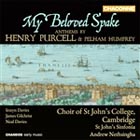 With
plenty of competition for the Purcell anthems it was sensible
of Chandos to kill two birds with one stone; by adding works
by the much less well-known Pelham Humfrey they are giving an
added incentive to buy this recording while at the same time
they are hedging their bets on Purcell’s apparently less
commercially viable mentor. Les Arts Florissants included two
Humfrey anthems, Lord I have sinned and A Hymne to
God the Father on a 2007 Purcell recording (3951442),
presumably with the same thought in mind.
With
plenty of competition for the Purcell anthems it was sensible
of Chandos to kill two birds with one stone; by adding works
by the much less well-known Pelham Humfrey they are giving an
added incentive to buy this recording while at the same time
they are hedging their bets on Purcell’s apparently less
commercially viable mentor. Les Arts Florissants included two
Humfrey anthems, Lord I have sinned and A Hymne to
God the Father on a 2007 Purcell recording (3951442),
presumably with the same thought in mind.
Nevertheless, Purcell is firmly in the driving seat here, with
over 50 minutes of music to Humfrey’s 18. Bearing in mind
what I’ve said about the availability of so many fine Purcell
recordings, I can’t help feeling that the new recording
would have been more competitive if the roles had been reversed.
There’s a substantial selection of Humfrey’s anthems
on Coro COR16041 : O Lord my God; Lord I have sinned;
O the sad day; By the waters of Babylon; Sleep downy sleep come
close mine eyes; the ubiquitous A Hymne to God the Father
and the ‘Club’ anthem in which Humfrey and Purcell
both had a hand, together with music by Blow and Cooke and an
even more substantial selection on a budget-price 3-CD set of
English Church Music by Byrd, Gibbons and Humfrey (Harmonia
Mundi HMX2907454/56): O give thanks unto the Lord;
O Lord my God; Have mercy upon me, O God; By the waters of Babylon;
Lift up your heads; Hear, O Heav’ns; Hear my prayer, O
God; Hear my crying, O God and Like as the hart.
Having owned for some time the single CD from which the Humfrey
anthems are taken, I can vouch for its high quality, but it
now comes coupled with music by Byrd and Gibbons which you may
already have, thereby negating some of the attraction of the
budget price. If I continue to recommend it above the present
recording, that’s largely because it offers a more complete
picture.
Apart from those recordings there are just two anthems which
get a regular airing:
Hear O Heavens on a CD
of Verse Anthems from (John) Bull to Blow, Deux-Elles DXL853,
in A Treasury of English Church Music (EMI 0846402,
5 CDs at budget price) and in a programme of music by Blow,
Locke and Purcell, Nimbus NI5454
A Hymne to God the Father on Counter-tenor duets
and song, Deux-Elles DXL911, on God be in my Head
(Guild GMCD7308 review),
another Guild CD, A quiet conscience (GMCD7150),
with a programme entitled Remember your lovers (Signum
SIGCD066 review),
on An Evening Hymn (Naxos 8.557129 review)
and on a programme entitled Praise & Majesty, Griffin
GCCD4076.
Reviewing the Nimbus CD on which Humfrey takes
a walk-on part among his contemporaries here
I’ve already made out a case for regarding him as a talented
composer who doesn’t deserve to be ignored. Jonathan Woolf
makes the same case in his review
of that CD. I think all concerned with the new Chandos recording
were wise not to include his over-exposed setting of Donne’s
Hymne to God. O Lord my God is less ubiquitous,
though you may have picked up a recording of it somewhere, but
the two short Evensong settings are, I believe, unique in the
current catalogue and I don’t recall having seen them recorded
elsewhere. The St John’s performances certainly make a
good case for redressing his neglect.
Indeed, all the performances here maintain the high standards
that Andrew Nethsingha has upheld at St John’s since taking
over from his distinguished predecessor, Christopher Robinson,
whose recordings of the 20th-century English choral tradition
are one of the glories of the Naxos catalogue.
Robinson did not, to the best of my knowledge, record Purcell
with the choir, but there’s an obvious benchmark in the
complete sacred music which New College Choir, Oxford, recorded
for Hyperion with the King’s Consort (CDS44141/51;
individual CDS available from Archive Service or as downloads
review).
Andrew Nethsingha’s chosen tempi are similar to those of
Robert King a little faster if anything and there’s
not a great deal to choose between them, but I thought the Hyperion
performances just a little lighter and, despite the availability
of 24-bit sound from Chandos, just as well recorded. Both combine
scholarship (chosen pitch and tuning are outlined in the Chandos
booklet) with musicality.
If you want to do the comparison for yourself, the ‘Bell’
Anthem, Z49, is included on an inexpensive (£4.99) sampler
of the Hyperion series of King’s Purcell recordings (KING2)
and subscribers to the Naxos Music Library can hear the Chandos
there. St John’s round off their recording with this, the
best-known of Purcell’s anthems. It derives its nickname
from the imitation of bell chimes in the instrumental introduction
and I thought that the new recording achieved this effect slightly
less than King or Edward Higginbottom with New College Choir
(CRD3504) or Gustav Leonhardt with King’s College
Choir, Cambridge (Warner Teldec 2564686992). On the other
hand Nethsingha’s faster tempo much faster than Higginbottom’s
or Leonhardt’s and sprightly rhythm ensure that the programme
ends on a suitably up-beat note. You can do the comparison between
Nethsingha, Higginbottom and Leonhardt yourself if you subscribe
to Naxos Music Library all three are there.
You’ll learn something of the connection between Humfrey
and Purcell as mentor and student from the NVC Arts DVD England
my England review
though I hope you don’t find it as tedious a programme
as I did; the CD that comes with it is worth having.
What goes around comes around. The Naxos recording of evening
music which I’ve listed above among the recordings of the
Hymne to God was recorded by a solo treble with St John’s
College Choir who now, with a different director, return to
Humfrey’s music. That Naxos recording seems to be hard
to come by from UK online dealers, though it’s available
for streaming from the Naxos Music Library and as a download
from classicsonline.com
(mp3 with booklet).
If you want the programme being offered on the new Chandos recording
I don’t think you’ll be disappointed but don’t
be surprised if you don’t know Purcell or Humfrey well
and find yourself also buying one of the other recordings that
I’ve listed perhaps even the complete Hyperion Purcell
sacred music.
While on the subject of Chandos recordings of St John’s
Choir and Andrew Nethsingha, it’s seasonally appropriate
to remind you of their recording from last year On Christmas
Night (CHSA/CHAN5096: Recording of the Month
review
review
and December 2011/1 Roundup).
Franz SCHUBERT (1797-1828)
String Quintet in C, D956* [54:35]
String Quartet No. 12 in c minor (fragment), D703 ‘Quartettsatz’[9:06]
Takács Quartet
* with Ralph Kirshbaum (cello) rec. May 2012. DDD.
HYPERION CDA67864 [63:41] from hyperion-records.co.uk
(mp3, 16 and 24-bit lossless)
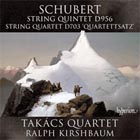 I
haven’t yet managed more than a cursory first hearing of
this recording, so I’m grateful to Geoff Molyneux for his
review:
I
haven’t yet managed more than a cursory first hearing of
this recording, so I’m grateful to Geoff Molyneux for his
review:
The Takács players straightaway set the serious tone
and mood for their performance of one of the great masterpieces
of music. The drama of the first movement unfolds in a performance
characterised by a sense of solidity and architecture, passion
and beauty, and moments of great intensity contrasted with more
relaxed sections. One of my favourite recordings of this work
is the excellent performance given by the Brandis Quartet. Their
recording on Nimbus is slightly more resonant and the rubato
is more pronounced than with the Takács players, but
there are places in the latter where the individual parts are
clearer. The Brandis players give a really quiet and touching
account of the second subject main theme in this first movement.
Another good performance is given by the Schubert Quintet on
the Genuin label. This is a very heartfelt and beautifully coloured
performance and I like its emotional quality although I feel
that some of the rubato is not always under control and the
recording does not do the players full justice.
The second movement is lovingly played by the Takács
players but I have a preference for the Brandis musicians who
move along fractionally faster and they play with a warmer tone.
The Brandis players are more passionate in the F minor middle
section and have a fuller and richer sound. Now and then I can
hear some breathing sounds from the Takács players during
some of the quiet chords, and personally I would find this a
little irritating on repeated hearings. The Aeolian Quartet
with Bruno Schrecker give a fine performance on Regis*. Their
Adagio is slower than most and this is a very moving
performance.
The third movement scherzo is a fiery affair with a solemn
Trio in a slower tempo, and it is all superbly played
by the Takács players. The Hungarian Quartet give an
exciting performance of this movement but the recording sounds
dated and there are a few bars of poor intonation. Again the
Nimbus is a bit over resonant for my taste whilst Hyperion gives
us a little more clarity and rhythmic bite. I prefer the Takács
in this movement, but I hate to hear breathing sounds from string
players in chamber music, and this can be heard again in the
trio.
The fourth movement Allegretto is beautifully played,
but the Belcea Quartet with Valentin Urban finds a bit more
humour when needed in this finale in their superb account on
EMI Classics
The Takács give an excellent, deeply thought account
of this work and it seems good value as you also get a fine
performance of the Quartettsatz, whereas the Brandis
give us only the Quintet. Also the Hyperion is the best recorded
of the versions I heard. It is very spacious allowing for a
wide range of dynamics and just the right degree of resonance.
I do have a marginal preference for the performance from the
Brandis Quartet with Wen-Sin Yang. However my first choice,
which for me the most moving performance of all, is that given
by the Belcea Quartet with Valentin Urban. The players seem
to have totally convincing flexibility in their rubato and a
potent mix of delicacy and passion. It is fabulously recorded
too.
Geoffrey Molyneux
* RRC1278 - one of the earliest
CDs that I reviewed for MusicWeb - here
- and one of my favourite versions. [BW]
Franz SCHUBERT
Die Schöne Müllerin, D795
Dietrich Fischer-Dieskau (baritone); Andras Schiff (piano)
rec Schubertiade, Feldkirch, 1991.
Picture format NTSC 4:3
PCM Stereo
Region 0 (all regions)
Subtitles: English, German, French, Spanish, Italian
Bonus: Fischer-Dieskau in conversation with Franz Zoglauer (1985)
ARTHAUS MUSIC DVD 107269 [83:00]
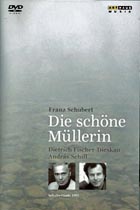 I
had the highest expectations of this DVD two of my all-time
favourite Schubert interpreters recorded together at the 1991
Schubertiade in one of the composer’s two masterpiece song
cycles. The earlier release on TDK (TVCODSM) had earned
encomia from Gramophone and the Penguin Guide and Fischer-Dieskau’s
3-CD set of the three great song cycles, Die Schöne
Müllerin, Die Winterreise and Schwanengesang,
with Gerald Moore on DG (477 7956) offers wonderful performances
and one of the great bargains of the catalogue.
I
had the highest expectations of this DVD two of my all-time
favourite Schubert interpreters recorded together at the 1991
Schubertiade in one of the composer’s two masterpiece song
cycles. The earlier release on TDK (TVCODSM) had earned
encomia from Gramophone and the Penguin Guide and Fischer-Dieskau’s
3-CD set of the three great song cycles, Die Schöne
Müllerin, Die Winterreise and Schwanengesang,
with Gerald Moore on DG (477 7956) offers wonderful performances
and one of the great bargains of the catalogue.
In the event, if we had a Disappointment of the Month category,
this would fit it. I can (just) understand why some reviewers
have rated it highly there are traces of the old, great, voice
and interpretation there and it’s apparent that the two
performers gelled in their enjoyment of working together. For
me, however, the 66-year-old voice had simply become too wavery
and lacking in dynamic range and all the facial and body-language
which Fischer-Dieskau employs not only cannot compensate but
looks rather pathetic. Whenever he sings War es also gemeint?
was it fated to be so? I can’t help thinking how time
and fate rob us all of our powers, even the greatest among us.
As Anne Ozorio writes in her review
of that TDK release, it seems almost cruel to listen to this
performance critically but that’s what you expect us to
do. The audience react rapturously, but there’s surely
an element of the Emperor’s New Clothes or a memory of
better times in their response. Writing about another Arthaus
DVD release of this recording with Die Winterreise, Kirk
McElhearn thought that the merits of the earlier recording of
Winterreise atoned for the shortcomings of Die Schöne
Müllerin review
but he seems to have been a little more impressed by the latter
than Anne Ozorio and myself.
I turned for reassurance of how well Fischer-Dieskau had once
performed this work not to the DG set but to an EMI recording,
again with Gerald Moore in 1961, still available as an EMI Great
Recording review
and recently reissued less expensively on EMI Masters 0852092,
available to stream from Naxos Music Library if you wish to
check it out. See Bargain of the Month review
of an earlier EMI Masters release, with a different cover and
number; it’s hard to keep up with the speed with which
EMI have been reshuffling their catalogue recently. Ironically,
the seeds of the destruction of the great voice are heard even
at its height in the microscopically slight but attractive waveriness
that made the singer so distinctive that one has only to listen
to a few seconds of any of his recordings to recognise him.
I understand that Austrian Television (ÖRF) arranged to
record the occasion only at the last moment; having intended
only to film just a news item, they hastily drafted in an extra
camera. The result, considering the circumstances, does justice
to the occasion and it would be easy to disregard the shortcomings
of 21-year-old technology if the performance had warranted it.
As it is, though one can adjust the 4:3 picture to 16:9 without
distortion on most televisions, it’s not possible to compensate
for the grainy picture, with the occasional banding that used
to be common on VCR and the disconcerting impression that the
lighting was changing from minute to minute.
Stay with one of Fischer Dieskau’s recordings of this cycle
from better times with Gerald Moore. Alto have recently reissued
(the 1951?) recording, plus five Lieder, on ALC1207 and
that 1951 version, without the fillers, is also available on
Regis RRC1383 review
both at budget price. Otherwise, the EMI Masters is available
for around £8 and the 3-CD DG set costs around £16.
(It’s on special offer from one dealer at the moment for
£10.56). Then there’s the Hyperion recording of the
cycle on which Fischer Dieskau reads the prologue and epilogue
(as he does on the EMI recording) while Ian Bostridge and Graham
Johnson perform the music (CDA30020 or CDJ33025
around £8 or download in mp3 or lossless from hyperion-records.co.uk
see October 2010 Download Roundup).
Pyotr Ilyich TCHAIKOVSKY (1840-1893)
The Ballets
Christmas is a traditional time for the Tchaikovsky ballets
and the arrival of a new recording of Sleeping Beauty
from Chandos makes it even more appropriate to look at what’s
on offer.
The Sleeping Beauty, Op.66, ballet in a prologue
and three acts, à Mr Jean Wséwolojsky (1888-1890)
CD1
Introduction [2:34]
Prologue [27:53]
Act I [36:32]
Act II: First Tableau (beginning) [9:55]
CD2
Act II: First Tableau (conclusion) [22:16]
Second Tableau [8:01]
Act III [47:33]
James Ehnes (violin); Robert deMaine (cello); Johannes Wik (harp)
Bergen Philharmonic Orchestra/Neeme Järvi
rec. Grieghallen, Bergen, 18-23 June 2012. DSD.
CHANDOS CHSA5113(2) [77:14 + 77:56] SACD, mp3, 16
and 24-bit lossless and Studio Surround from theclassicalshop.net.
My benchmarks for Sleeping Beauty are:
Paris Conservatoire Orchestra/Anatole
Fistoulari (abridged) rec.1952: NAXOS CLASSICAL ARCHIVES
9.80559/60 [104:47] from eclassical.com
(mp3 and lossless)
Minneapolis Symphony Orchestra/Antal Doráti rec.1955:
NAXOS CLASSICAL ARCHIVES 9.80591/3: Bargain of
the Month September 2011/2 Download
Roundup
Philharmonia Orchestra/George Weldon (slightly abridged)
rec. c.1958: EMI CLASSICS FOR PLEASURE 3932382 September
2011/2 Download
Roundup
[still available from classicsonline.com for £4.99]
Royal Opera House Covent Garden Orchestra/Mark Ermler rec.1989
[the original Conifer CDs, the single-CD highlights CD (ROH003)
and the Sony reissue (88697575302) are no longer available
in the UK, but worth searching for.]
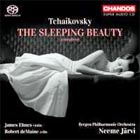
As far as the quality of sound is concerned,
there’s no competition for the new Chandos recording; I
listened to the 24/96 version, until recently top of the range,
though even that format is in danger of becoming old hat, with
surround sound versions available of many recent Chandos recordings,
including this, and 24/192 rapidly becoming the norm.
Nor do I think that purchasers will be disappointed with the
performance from the Bergen PO, fast making a reputation for
itself on a number of labels, with Neeme Järvi at the helm
and James Ehnes on hand for the important violin solos. Completists
will be particularly pleased as far as I’m aware the
score is performed complete; though I’m certainly not ruling
out older recordings which are slightly abridged (see below),
the completeness, combined with the quality of performance and
recording makes this my version of choice now, though there’s
no such thing as the one and only ideal version of the work.
Add the detailed 59-page booklet and the choice is clear unfortunately
you’ll find that if you print this it will be too large
to fit into a CD case. In any event, the 24/96 recording won’t
fit onto two CDs; you’ll need to be able to burn an audio
DVD or run to three CDs.
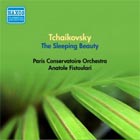 Of
the older recordings Doráti and Fistoulari remain well
worth hearing. I listened to the Doráti in the mp3 transfer
available from emusic.com and thought the sound decidedly dated
though listenable. You can obtain that and the Fistoulari in
lossless flac from eclassical.com
and, though the price of $18.86 might seem steep for the latter
against £1.68 for the mp3 from emusic.com and £3.98
from classicsonline.com, the sound in flac is unbelievably good
for its age. This classic version has been given a new lease
of life. The music is given in abridged form, as is the Weldon,
though the latter slightly less so, but I’m surprised to
find myself inclined to prefer either to Doráti, whose
version was for long my only recording of the work. With iTunes
charging $17.99/£13.99 for the Past Classics transfer
of this Fistoulari recording in mp3 only and presumably not
the full 320kb/s at that the eclassical.com price doesn’t
seem too steep for the quality.
Of
the older recordings Doráti and Fistoulari remain well
worth hearing. I listened to the Doráti in the mp3 transfer
available from emusic.com and thought the sound decidedly dated
though listenable. You can obtain that and the Fistoulari in
lossless flac from eclassical.com
and, though the price of $18.86 might seem steep for the latter
against £1.68 for the mp3 from emusic.com and £3.98
from classicsonline.com, the sound in flac is unbelievably good
for its age. This classic version has been given a new lease
of life. The music is given in abridged form, as is the Weldon,
though the latter slightly less so, but I’m surprised to
find myself inclined to prefer either to Doráti, whose
version was for long my only recording of the work. With iTunes
charging $17.99/£13.99 for the Past Classics transfer
of this Fistoulari recording in mp3 only and presumably not
the full 320kb/s at that the eclassical.com price doesn’t
seem too steep for the quality.
I must have heard Sleeping Beauty almost as many times
as I’ve had hot dinners, but, guided by any of the recordings
that I’ve mentioned, not least the new Chandos, it never
stales. That’s even more true of ...
The Nutcracker
National Philharmonic Orchestra/Richard
Bonynge (with Jacques OFFENBACH
Le Papillpon): Double Decca 444 8272 see November
2010 Download
Roundup.
NB: the passionato.com link no longer applies download from
hmvdigital.com for £7.49 here
or here.
Berlin Philharmonic/Simon Rattle: EMI 6463852 [43:47
+ 42:37] review
and December 2010 Download
Roundup (Download of the Month)
LSO/André Previn (with Romeo and Juliet, Marche
Slave, 1812 and PROKOFIEV
Cinderella (highlights): EMI CLASSICS FOR PLEASURE 0094639323357
September 2011 Download
Roundup
[NB: this is now priced at £8.99 by classicsonline.com;
the alternative coupling with la Sylphide, EMI 9676892,
is far and away better value at £3.49 from hmvdigital.com.]
Russian National Orchestra/Mikhail Pletnev: ONDINE ODE1180/2D
December 2011/2 Download
Roundup
While the Ansermet version (Decca Eloquence)
remains firmly at the top of my tree, Previn makes an excellent
inexpensive download alternative and the plush recent Rattle
version is also highly recommendable. Pletnev, on the other
hand, is decidedly not for me. There’s a ridiculously inexpensive
download of the Ansermet from Past Classics £1.26 from
emusic.com
or £2.97 from hmvdigital.com.
The short samples that I’ve listened to sound a bit thin
by comparison with my earlier Decca CDs but tolerable.
Swan Lake
Minneapolis Symphony Orchestra/Antal
Doráti (1957): Past Classics [131:34] from emusic.com
or hmvdigital.com
London Symphony Orchestra/Anatole Fistoulari (1952): Naxos
Historical 9.80274/5 from classicsonline.com
Ida Haendel (violin), Douglas Cummings (cello), London Symphony
Orchestra/André Previn (1976): Classics for Pleasure
or EMI.
The Past Classics transfer of the Doráti
is much better than that of Sleeping Beauty thin but
more than tolerable; it’s the least expensive version around
at £1.68 or £3.96 and the performance holds its
own against more recent versions. Hmvdigital.com also have a
(probably preferable) Decca transfer of this recording for £7.49
and eclassical.com
have the Fistoulari in lossless sound; it’s $16.00 but,
given the superiority of their transfer of Sleeping Beauty,
probably worth the outlay, though the classicsonline.com
transfer, at £3.98, sounds good for its age. For a comparison
of these three versions, please refer to the September 2011/2
Download
Roundup.
Of highly regarded more recent versions that recorded by the
Montréal Orchestra and Charles Dutoit is available for
£8.49 from hmvdigital.com.
Gustav MAHLER (1860-1911)
Symphony No. 9 in D (1909-1910)
Royal Stockholm Philharmonic Orchestra/Alan Gilbert
rec. 2-7 June 2008, Concert Hall, Stockholm, Sweden. DSD.
Pdf booklet included
BIS-SACD-1710 [82:22] from eclassical.com
(mp3, 16 and 24-bit lossless)
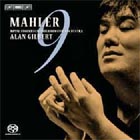 Alan
Gilbert’s recent performance of this symphony in New York
made headlines for all the wrong reasons; a punter’s mobile
rang in the Finale, bringing the concert to a brief halt. As
any concertgoer knows these devices are a menace, and despite
many warnings they still go off at the most inopportune times.
Fortunately this Stockholm recording came to prominence for
all the right reasons; it’s been very well reviewed elsewhere,
but it was hearing Gilbert’s New York Nielsen 2 and 3
review
that prompted me to download the 24-bit version of this recording.
Alan
Gilbert’s recent performance of this symphony in New York
made headlines for all the wrong reasons; a punter’s mobile
rang in the Finale, bringing the concert to a brief halt. As
any concertgoer knows these devices are a menace, and despite
many warnings they still go off at the most inopportune times.
Fortunately this Stockholm recording came to prominence for
all the right reasons; it’s been very well reviewed elsewhere,
but it was hearing Gilbert’s New York Nielsen 2 and 3
review
that prompted me to download the 24-bit version of this recording.
I’m so glad I did, for it has the same directness a lack
of sentimentality if you will that makes those Nielsen symphonies
sound so fresh and invigorating. Indeed, this quest for clarity
is matched by a recording of breath-taking detail and subtlety,
not to mention playing of sustained power and rare concentration.
As for tempi and tempo relationships so often the undoing
of this fragmenting symphony they’re perfectly judged;
textures are wonderfully aerated too. My only caveat is that
tuttis seem a little fierce, but that hardly matters when the
music-making is as good as this.
After that contained Andante comodo the Ländler-driven
second movement majors in point and propulsion. Gilbert is not
one to indulge in Lenny-like liberties of tempo or phrasing;
that really counts in the wide-eyed innocence of this music,
with its fond echoes of the Wunderhorn-inspired Fourth
Symphony. Others may find more charm in these notes, but there’s
no denying the overall integrity and ‘rightness’ of
Gilbert’s conception. Factor in pin-sharp articulation
the woodwind playing is especially characterful, their trills
simply gorgeous and it’s little wonder this performance
sounds so engaging.
The trenchant Rondo-Burleske certainly benefits from
the swift, no-nonsense reading it gets here; that said, essential
colour and rusticity is very much in evidence, thanks to alert
playing and intuitive direction. Some listeners may feel Gilbert
underplays the sheer heft of this symphony, but others may think
as I do that transparency and lift are more important in
such a paradigm-shifting piece. Even in this movement there
are unsettling moments where one begins to sense that, to borrow
Yeats’s momentous phrase, ‘the centre cannot hold’.
The long-breathed Adagio, surely the most evanescent
in all music, seems to wither and bloom at once; these existential
opposites are superbly caught in massed string playing of rare
conviction and strength, while Gilbert ensures just enough thrust
to sustain the valedictory mood without it becoming fitful.
In a movement well-known for its hushed intensity you’d
be hard-pressed to find it more beautifully played than it is
here. The soft, ear-pricking detail is just extraordinary, and
those strange, desolate timbres are haunting beyond measure.
The recording is exceptionally well balanced, the dynamic extremes
encompassed with ease. This is Mahler playing of an exalted
order and proof, if it were needed, that Gilbert is a first-rate
conductor from whom we can expect great things.
A transfigured and transfiguring Ninth; a must-hear for
all Mahlerians
Dan Morgan
http://twitter.com/mahlerei
[As usual when Dan has reviewed the 24-bit version I listened
to the ‘ordinary’ 16-bit. Prospective purchasers unable
to run to the cost of the 24-bit ($17.07 as against $12.20)
need not worry the CD-quality version sound fine, too.
This recording joins the classic Barbirolli (EMI) and Haitink
(BR Klassik or Philips) at the top of the tree see July 2012/2
Download
Roundup. Fans of Michael Tilson Thomas and the San Francisco
SO will find a good, though not outstanding, version on SFS
Media review
download from emusic.com
or classicsonline.com
or stream from Naxos Music Library.]
Sergei RACHMANINOV (1873-1943)
The Isle of the Dead, Op.29 (1909) [21:45]
Utyos, The Rock, Op.7 (1893) [13:31]
Symphonic Dances, Op.45 (1942) [35:11]
Bergen Philharmonic Orchestra/Andrew Litton rec. March 2008,
June 2009. DSD
BIS-SACD-1751 [71:27] from eclassical.com
(mp3 16 and 24-bit lossless) or stream from Naxos Music Library
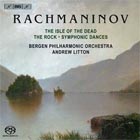 This
BIS release contains exactly the same programme, though presented
in a different order, as that offered by Vasily Petrenko and
the RLPO on Avie AV2188, which John Quinn made Recording
of the Month with a strong endorsement from Rob Barnett
review
and which I also recommended in the May 2010 Roundup,
so there’s strong competition indeed. Bargain hunters will
also find the same programme on a recording from the Royal Stockholm
Philharmonic conducted by Andrew Davis at £2.99 from classicsonline.com
and for streaming from Naxos Music Library: this version of
The Isle of the Dead, complete with the Böcklin
painting, is available on YouTube.
(Also available on CD at budget price: Warner Apex 2564609582)
This
BIS release contains exactly the same programme, though presented
in a different order, as that offered by Vasily Petrenko and
the RLPO on Avie AV2188, which John Quinn made Recording
of the Month with a strong endorsement from Rob Barnett
review
and which I also recommended in the May 2010 Roundup,
so there’s strong competition indeed. Bargain hunters will
also find the same programme on a recording from the Royal Stockholm
Philharmonic conducted by Andrew Davis at £2.99 from classicsonline.com
and for streaming from Naxos Music Library: this version of
The Isle of the Dead, complete with the Böcklin
painting, is available on YouTube.
(Also available on CD at budget price: Warner Apex 2564609582)
On BIS The Isle of the Dead comes first, a work inspired
by a mysterious painting of a ghostly figure piloting a boat
with a coffin towards an island. Rachmaninov was not the first
composer to be inspired by Böcklin’s painting; it
would be interesting, but probably commercially unviable, if
some kind record company were to offer us Heinrich Schulz-Beuthen’s
1890 work of the same name.
Petrenko, who places The Isle between the Symphonic
Dances and The Rock, gives the music fractionally
less time to make its effect yet, possibly because the contrast
with the cheery mood of the dances is more marked by his playing
order, his performance is marginally more atmospheric, but there
isn’t a great deal in it. Davis, who sounds at least as
mysterious as either of these, is also marginally slower than
Petrenko; all three give the music a little more breathing space
than Ormandy, whose 1954 recording is available on Naxos Historical
Archives. All three orchestras give of their best something
which with Andrew Litton (and Neeme Järvi in the new Sleeping
Beauty, reviewed above) in Bergen and Vasily Petrenko in
Liverpool is almost to be taken for granted.
None of these recordings quite effaces memories of Ormandy’s
recording of the Dances he gave the first performance.
I thoughtr was no longer available in any format but Classical
Edior Rob Barnett tells me that it’s still to be had on
Sony Essential Classics SBK48279 via amazon.co.uk..
(Stock is very low, however, in the UK.) Honours are about even
in The Rock.
The Avie and Finlandia recordings are available as downloads
in mp3 only from classicsonline.com, so the new BIS recording
as delivered in 16 and 24-bit lossless sound and with the booklet
as part of the deal, has the edge in that respect; both are
currently offered at $10.72; though the price of the 24-bit
will have risen a little by the time that you read my review,
that’s competitive with classicsonline.com’s £7.99.
There’s also currently a 30% discount on the three suites
from Prokofiev’s Romeo and Juliet for purchasers;
again, it will have been withdrawn by the time that you read
this, but I mention it as a reminder to keep an eye open for
these regular offers from eclassical.com.
If you are just looking for Isle of the Dead, you may
wish to consider the Chandos recording which couples it with
the ‘Youth’ Symphony and Symphony No.1 (CHAN10475
from theclassicalshop.net
in mp3 and 16 and 24-bit lossless.) As we don’t seem to
have reviewed that, I hope to include it in a future Download
News. [First reaction: this version of the Symphony is as fine
as any that I’ve heard, the ‘Youth’ Symphony
is well worth hearing and the performance of Isle of the
Dead is pretty good, too.]
Richard ARNELL (b.1917)
Symphony No. 4, Op.52 (1948) [26:36]
Symphony No. 5, Op.77 (1955-57) [36:48]
Royal Scottish National Orchestra/Martin Yates rec. May 2007.
DDD
DUTTON EPOCH CDLX7194 [63:49] from amazon.co.uk
(mp3)
[‘Two fine symphonies embracing the extremes of emotion
and one devastatingly likeable and radiantly strong.’ Recording
of the Month see review
by Rob Barnett.]
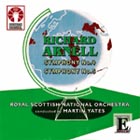 Rob
Barnett’s enthusiastic review says it all, except to report
that the amazon.co.uk download sounds fine, although the bit-rate
actually falls below Amazon’s supposed 256kb/s, itself
not the best mp3. The booklet of notes which RB praised doesn’t
come with the download and Dutton don’t even offer the
short notes on their website that they usually carry just
a brief recommendation from Fanfare but RB’s review should
help place the music for you.
Rob
Barnett’s enthusiastic review says it all, except to report
that the amazon.co.uk download sounds fine, although the bit-rate
actually falls below Amazon’s supposed 256kb/s, itself
not the best mp3. The booklet of notes which RB praised doesn’t
come with the download and Dutton don’t even offer the
short notes on their website that they usually carry just
a brief recommendation from Fanfare but RB’s review should
help place the music for you.
For no logical reason that I can ascertain amazon.co.uk charge
a wide range of prices for Dutton downloads; at £5.34
this is one of the least expensive an added incentive for
me, too, as I have to pay just like you for downloads from Amazon.
Pipe Dreams
José SEREBRIER (b. 1938)
Flute Concerto with Tango (2008) (Dedicated to Sharon Bezaly)
[22:12]
Adina IZARRA (b. 1959) Pitangus
Sulphuratus (1987, rev. 2007)* [15:05]
(2007 version commissioned by Robert von Bahr and dedicated
to Sharon Bezaly).
Carl VINE (b. 1954) Pipe
Dreams (2003) (Recorded in the presence of the composer) [14:53]
Alberto GINASTERA (1916-83)
Impresiones de la Puna (1934)
Sharon Bezaly (flute)
Australian Chamber Orchestra/Richard Tognetti rec. October
2009. DDD
Pdf booklet included.
BIS-CD-1789 [60:23] from eclassical.com
(mp3, 16 and 24-bit lossless) or stream from Naxos Music Library
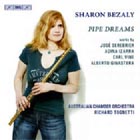 Sharon
Bezaly is the girl with the golden flute, specially made for
her in 24 carat; she uses that and, on track 3, the dreamy Fantasia
movement of the Serebrier work, a platinum-plated silver model,
to bring us a programme of music largely written by contemporary
composers. I enjoyed her programme of baroque music in which
she was accompanied by members of London Baroque (BIS-CD-1689
review)
so I was intrigued to see how she would respond to the very
different music on this album. In the event it’s just as
recommendable though perhaps to a different clientele. In common
parlance pipe dreams are unattainable but that doesn’t
apply to this recording.
Sharon
Bezaly is the girl with the golden flute, specially made for
her in 24 carat; she uses that and, on track 3, the dreamy Fantasia
movement of the Serebrier work, a platinum-plated silver model,
to bring us a programme of music largely written by contemporary
composers. I enjoyed her programme of baroque music in which
she was accompanied by members of London Baroque (BIS-CD-1689
review)
so I was intrigued to see how she would respond to the very
different music on this album. In the event it’s just as
recommendable though perhaps to a different clientele. In common
parlance pipe dreams are unattainable but that doesn’t
apply to this recording.
José Serebrier is better known as a conductor than as
a composer but his Flute Concerto with Tango suggests
that his creative work deserves to be as well known as his interpretative
skills. The third movement, fantasia, is ethereal; I
was more impressed with that than with the following movement,
tango inconclusivo, which, as its title suggests, presents something
of a deconstruction of the tango as Ravel’s La Valse
does of the waltz. There’s no other recording but, as the
work was dedicated to Sharon Bezaly, we can take this performance
as authoritative.
There’s one other recording of Pitangus Suphuratus,
also on BIS, who have something of a penchant for recording
flute music (Oiseaux tendres BIS-CD-689). The
programme of Pipe Dreams places the work with music roughly
contemporary with it; on the other hand, as the subject of the
work is a bird you won’t be surprised to hear echoes of
Messiaen, who also features on that earlier album.
The penultimate piece, an attractive work which gives its name
to the programme, is not available in any other recording. Impresiones
de la Puna, originally for flute and string quartet there’s
a version on another BIS CD, Sun-Flute 2/3 (BIS-CD-175)
is here played in an arrangement for flute and orchestra.
I can’t imagine any of the performances here being bettered
so, with good recording and a helpful booklet of notes, readers
looking for something different contemporary music that doesn’t
set the teeth on edge will find it well worth going for. I
have a mental line in the sand between Messiaen and his erstwhile
pupil Boulez; nothing here crosses that line to the dark side.
If in doubt, try it from the Naxos Music Library first.

